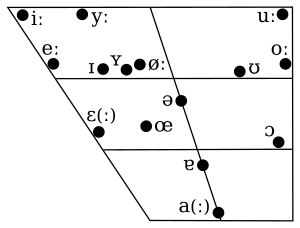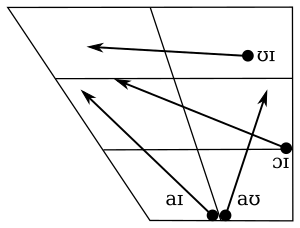Standard German phonology facts for kids
The phonology of Standard German is all about how the German language is spoken. It looks at the sounds used in German, how they are made, and how they fit together. It also explores how German sounds have changed over time and how different regions speak.
Contents
German Vowel Sounds
Vowels are sounds made when air flows freely from your mouth. German has many different vowel sounds. Some are short, and some are long.
Single Vowels
German has 14 single vowel sounds. These are called monophthongs. For example, the 'a' in Vater (father) is a long vowel. The 'a' in Mann (man) is a short vowel.
Vowel Combinations
Sometimes, two vowel sounds blend together in one syllable. These are called diphthongs. In German, there are three main diphthongs.
An example is the 'ei' sound in mein (my). Another is the 'au' sound in Haus (house). The 'eu' or 'äu' sound in neu (new) is also a diphthong.
German Consonant Sounds
German has 25 different consonant sounds. This is about average compared to other languages. Some German consonant sounds are quite special. One unique sound is the affricate. This sound starts like a stop and ends like a friction sound.
The Ich-Laut and Ach-Laut
German has two interesting sounds that are very similar. They are called the Ich-Laut and the Ach-Laut. The word Laut means 'sound' in German.
The Ich-Laut is the sound you hear at the end of the word ich (meaning 'I'). It sounds like a soft 'sh' sound, but made further back in your mouth. You use it after front vowels like 'i' or 'e'. You also use it after consonants.
The Ach-Laut is the sound at the end of the word ach (meaning 'oh' or 'alas'). This sound is made even further back in your throat. It sounds a bit like clearing your throat gently. You use it after back vowels like 'a', 'o', or 'u'.
These two sounds are like brothers; they never appear in the same place. This means if a word has a front vowel, you'll use the Ich-Laut. If it has a back vowel, you'll use the Ach-Laut.
See also
 In Spanish: Fonología del alemán para niños
In Spanish: Fonología del alemán para niños



